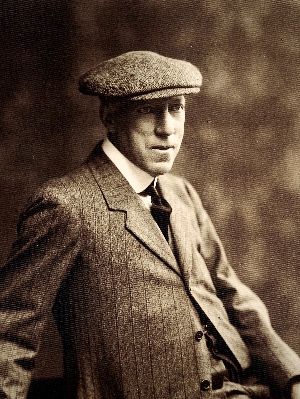Walton, William
Dancer
Collection date: Mar 1919
Area: Oxfordshire
William ‘Binx’ Walton of Adderbury Morris (1837-1919): William Walton was baptized at Adderbury on 8/2/1837, 4th of 5 sons of William Walton Snr, mason and his wife Susannah. William Snr died in January 1848, aged 41 and Susannah, a lacemaker, had to make ends meet until her sons took on work. William Jr told Sharp that he was actually taken into the workhouse for a time until a bricklayer and builder offered him an apprenticeship. In the 1851 census William was listed as a labourer, aged 14 back at home with his mother and older brothers. In succeeding censuses he was a mason, builder, shopkeeper and innkeeper (The Wheatsheaf pub 1891) at various turns. He married Ann Colledge on 29/12/1857 at Adderbury and they had 7 children.
William Walton was a survivor from the old Adderbury morris side that last performed in the late 1870s. At its peak Adderbury could put out 3 sides that would tour different local villages during Whitsun week, meeting up at Banbury Fair with the Long Hanborough and Wootton dancers. Walton said that he was leader of his side for 20 years. In addition he was a good singer and sang several folk songs to collector Janet Blunt (see separate profile) between 1916-19. The Adderbury men were known to entertain their crowd by singing in between dances while they took a rest. Introductory singing remains a distinctive feature of Adderbury dances today (e.g. Postman’s Knock, Happy Man, Sweet Jenny Jones etc).
A boys’ morris side was revived for Empire Day* on 26 May 1908 – the first Empire Day had been held on 24th May 1902 in memory of Queen Victoria’s birthday. About 260 children took part in the initial procession, led by the Bloxham church band. Thomas and Anne Walker, the Adderbury village schoolteachers had trained children in Maypole dancing and Miss Frances Hoskyns had coached the morris dancers. There is no mention of any Esperance trainer sent from London and one assumes that Miss Hoskyns trained the boys in the Headington style from the Morris Book manual produced by Sharp in April 1907.
*This Empire Day event was reported in the Banbury Guardian newspaper (28 May) and research by Barry Davis and Vera Wood is presented by Tim Radford online at http://historyofadderbury.co.uk/female-influences-on-morris-dance-in-adderbury-3
The boys’ morris was not a one-event project. Daisy Daking, an EFDS teacher from London (see separate profile), was posted to Oxford and lived there for 3 years (1912-15). From Feb 1913 she ran a course of folk dancing (price 2/-) in Adderbury for both sexes. Men and boys could learn the newly collected sword dances. Miss Blunt wrote to Clive Carey to say that a Bledington dancer (Mr Gibbs) had been demonstrating two jigs ‘Princess Royal’ and ‘Bacca Pipes’ to the boys’ morris class ‘under Miss Daking’ (vwml CC/2/7). However, it seems that the traditional Adderbury dancers were not much consulted or used in this revival. Sadly, most of the boys’ side were killed in the First World War and there was no further dancing in the village until 1975.
For one reason or another, Janet Blunt did not engage with William Walton until 1916. He sang 10 folksongs to her as well as several church songs. He also sang and performed 14 morris dances and 2 jigs for her over several visits, commencing in April 1916. In June that year Miss Blunt had the help of Mrs May Elliot Hobbs, a keen member of the Oxford EFDS, to note the figures for 4 dances (The Buffoon, Beaux of London City, Shepherds Hey and Black Joke: for image of Walton, type JHB/17B/7 in vwml search box). In Dec 1916 Walton happened to be in London and demonstrated at least 3 dances to Miss (Helen) Kennedy, sister of Douglas Kennedy (her notes survived).
After Janet Blunt’s final session with Walton (3 songs) in March 1919, she recommended that he visit Sharp in London, so on 25 and 29 March 1919 he called on Sharp and his assistant Maud Karpeles in Hampstead. They noted down 8 dances to their satisfaction but didn’t get any jigs – Walton was by now aged 82! The notes were typed out as Folk Dance Notes 4/57-78 and then 5 dances were published in Morris Book 2 (2nd edition Novello 1919). Sharp wrote most politely to Miss Blunt to ask her permission to publish the dances and acknowledged her contribution in the preface.
There are some points of difference between Sharp’s notes and Blunt’s notes, so that when the traditional dances were revived in 1975 by Tim Radford and the late Bryan Sheppard, they could access both sets of notes. Lionel Bacon merged materials in his ‘Handbook of Morris Dances' (1974 pp4-18).
Various Youtubes exist of the Adderbury dances, which are popular with many revival sides. There are 3 Adderbury morris sides today (in no particular order): Sharp and Blunt (Ladies’ side); Adderbury Morris Men; Adderbury Village Morris Men.
A DVD/film 'Way of the Morris' by Tim Plester about the Adderbury history was released in 2011.
William Walton died in July qr 1919 (3a 885) just months after meeting Sharp.

